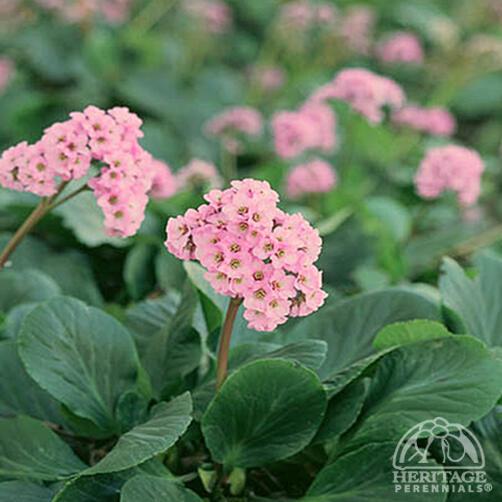Bergenia crassifolia
Plant number: 1.105.040Bergenia are incredibly hardy, and reliably evergreen throughout nearly the entire continent. This species is native to central and eastern Asia from Siberia and the Altay Mountains in Russia south through northern Mongolia into China where it grows on rocky cliffs some 5,000 feet high. The name comes from the Latin words “crass” which means “thick” and “folia” meaning “leaves” in reference to its thick leaves. The plant forms a low mound of bold, leathery, spoon-shaped green leaves, which often turn bronze during winter, especially in colder regions. Short stems of magenta-pink flowers rise taller in early to mid spring, much earlier than other forms. In mild regions this may well flower in winter. The winter leaves are a valuable addition to cut flower bouquets. Most effective when mass planted as a groundcover or used as an edging along a walkway. Lovely cut flower. Tolerates a wide range of soil conditions, in both sun or part shade. Easily divided in spring or early fall. Further details for |
Bergenia crassifolia
Plant number: 1.105.040Bergenia are incredibly hardy, and reliably evergreen throughout nearly the entire continent. This species is native to central and eastern Asia from Siberia and the Altay Mountains in Russia south through northern Mongolia into China where it grows on rocky cliffs some 5,000 feet high. The name comes from the Latin words “crass” which means “thick” and “folia” meaning “leaves” in reference to its thick leaves. The plant forms a low mound of bold, leathery, spoon-shaped green leaves, which often turn bronze during winter, especially in colder regions. Short stems of magenta-pink flowers rise taller in early to mid spring, much earlier than other forms. In mild regions this may well flower in winter. The winter leaves are a valuable addition to cut flower bouquets. Most effective when mass planted as a groundcover or used as an edging along a walkway. Lovely cut flower. Tolerates a wide range of soil conditions, in both sun or part shade. Easily divided in spring or early fall. Further details for |






